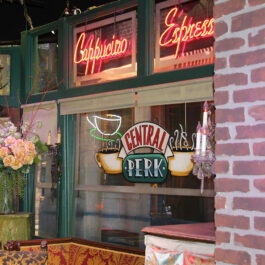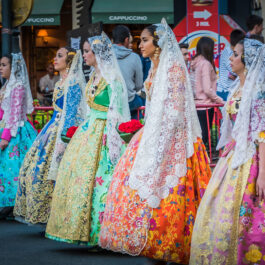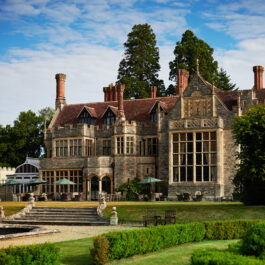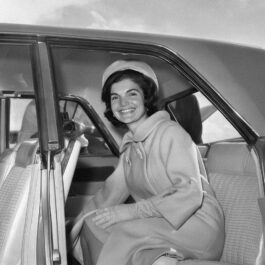Culture
50 Movie Posters That Defined Their Era
Movie PostersA teaser, an advertisement, a motivator – film posters have many jobs. From 1895 to the present day, these 50 movie posters have gone above and beyond the call of duty
By Jeremy Owen
0/51
Culture
50 Movie Posters That Defined Their Era.
L'Arroseur arroséL’Arroseur arrosé (1895) – Produced to promote the first-ever narrative feature film, this poster becomes notable simply due to circumstances. It establishes the convention of showing a scene from the film, but amusingly adds in an audience to give potential viewers a clear idea of what movie-going is all about. In this case, the drawing of ‘boy soaking man with hosepipe’ pretty much exposed the plot of the whole film. Notice there is also no mention of the title of the film, instead the producer gets full billing.
1/51
Culture
50 Movie Posters That Defined Their Era.
Trip to the MoonTrip to the Moon (1905) – Using stills from a film as a poster’s focal point was established very early on. And why not? As captivating images go, the whimsical man in the moon with a rocket in his eye is one of the most memorable images in cinema, if not the first real ‘pop’ image of the modern era.
2/51
Culture
50 Movie Posters That Defined Their Era.
Birth of a NationBirth of a Nation (1915) – Rendered in a populist style that audiences would recognise from pulpy illustrated magazines, a Klansman on rearing horseback is shockingly depicted without irony as an archetypal heroic figure, his flowing robes assuring the viewer of the epic quality of D.W. Griffith’s grandiose (but controversial even then) portrayal of the US being ‘rescued’ from the heathens by the KKK.
3/51
Culture
50 Movie Posters That Defined Their Era.
NosferatuNosferatu (1922) – Unusual as it uses a monster that visually looks nothing like the vampire character so frighteningly portrayed by Max Shreck in the film, but composition-wise it more than matches the Expressionist energy and movement of the film.
4/51
Culture
50 Movie Posters That Defined Their Era.
MetropolisMetropolis (1926) – Avoiding robots and sinister typography of the more famous versions, this rendering for the French market focuses on the motif of the city itself to suggest the maniacal modernity of the film’s plot. Its compatriots remain firmly in their period, but Russian illustrator Boris Bilinsky here achieves a timeless quality that could easily be promoting a contemporary remake.
5/51
Culture
50 Movie Posters That Defined Their Era.
King KongKing Kong (1933) – When you have a huge gorilla on a skyscraper in your film, your poster options becomes fairly easy. Of course it’s all in the execution, but this, the original outing of the screen favourite, establishes the Big Monster mythology by using the film’s pivotal scene as its cue before upping the excitement to suitably gargantuan proportions through an iconic illustration and that legendary typography.
6/51
Culture
50 Movie Posters That Defined Their Era.
Le Grande IllusionLe Grande Illusion (French, 1937) – This is the film poster elevated to political statement. There is no doubt that it was inspired by the visual language of propaganda posters of the period. It does its job and advertises the theme of Renoir’s film, and in so doing it stands, sorrowfully, as its own beautifully conceived litmus test of a critical time in world history.
7/51
Culture
50 Movie Posters That Defined Their Era.
CasablancaCasablanca (1942) – The cascade of stars was a staple of 1940s film design and, as we might expect, Casablanca is a classic example. The portrait painting is peerless; the warm glow implies intrigue, the composition of faces around Bogart’s fedora a suggestion of Rick’s dilemmas, his pose with pistol the confirmation. Coupled with the period typography, it conveys both the glamour implicit to the story and screams ‘big studio production.’
8/51
Culture
50 Movie Posters That Defined Their Era.
All About EveAll About Eve (1950) – Nowadays we would call this ‘infographic’, but in the ‘50s it was simply ‘graphic’; either way, its use of photo cut-outs and arrows conveys the setup of the film quickly, whilst the flat colours make it do so very, very stylishly. It’s abundantly clear that this is a modern film for modern people.
9/51
Culture
50 Movie Posters That Defined Their Era.
GiantGiant (1956) – This captivating mix of cowboy iconography and rock ‘n’ roll attitude is unusual, as it was created after the film was released. The original was fairly forgettable, but as the film found an audience, this alternative was created to up the laconicism levels. It’s an essay in classical composition, the perfect triple hit of foreground, mid ground and the title of the film, unsurprisingly, writ large.
10/51
Culture
50 Movie Posters That Defined Their Era.
VertigoVertigo (1958) – This one puts itself firmly in the box labelled ‘modern art masterpieces’. It’s idiosyncratic – we see überdesigner Saul Bass’s trademarks all over it, with rough edges, flat shapes and bright colours – and yet it belongs firmly to Hitchcock’s picture. The falling figures and swirling vortex perfectly sell the McGuffin, plus, as Bass understood visual branding better than most of us even today, it ties in perfectly to the title sequence – which, incidentally, he created, too.
11/51
Culture
50 Movie Posters That Defined Their Era.
Ben HurBen Hur (1959) – An appropriately monolithic poster for the default ‘swords and sandals’ epic. This is graphic design at its most populist, but as an exercise in conveying an idea quickly – the ‘type as image’ – it’s the first chariot past the post: We are in no doubt of the scale of the film being advertised, or indeed, what it’s about.
12/51
Culture
50 Movie Posters That Defined Their Era.
Breakfast at Tiffany’sBreakfast at Tiffany’s (1961) – A technicolour poster for a technicolour film. It more than matches the sass required for Blake Edwards’ interpretation of the Truman Capote novella, mainly with the length of that cigarette holder. Riffing on both Mondrian and Blue Note, it’s like jazz visualised, but is notable for managing to adhere to marketing tools such as star portraits without ruining the overall effect.
13/51
Culture
50 Movie Posters That Defined Their Era.
Lawrence of ArabiaLawrence of Arabia (1962) – T.E. Lawrence is portrayed by Lean’s film as a man of humour dealing with a complicated, dangerous situation. Accordingly, the artwork brings the epic and the comic together. The former is drawn by the shadowed face with the splendid device of the Bedouin charge across the folds of his robes, the latter from the attitude of the supporting cast jostling for position behind.
14/51
Culture
50 Movie Posters That Defined Their Era.
Dr. StrangeloveDr. Strangelove. Or how I Learned to Stop Worrying And Love The Bomb (1963) – There are so many themes in Kubrick’s masterpiece a lesser poster would have struggled, but here, one perfectly balanced (comically and compositionally) satirical illustration gets them all across, and makes short change out of what must be the longest film title ever to boot.
15/51
Culture
50 Movie Posters That Defined Their Era.
Yeh Rastey Hain Pyar KeYeh Rastey Hain Pyar Ke (Indian, 1963) – A Bollywood film said to be ahead of its time, the poster also explored some new territory. The portraiture uses a slightly Expressionist method, but it’s the interplay between text and image to create a cohesive whole – not a just a set of elements – that displays a modern approach which mainstream Hollywood was only just starting to explore.
16/51
Culture
50 Movie Posters That Defined Their Era.
The Magnificent SevenThe Magnificent Seven (1966) – Master film designer Saul Bass’ masterful treatment for John Sturges’ masterpiece Western. The crude brushstrokes perfectly represent the film’s tone without any mention of specifics, as well as bringing to mind Kurosawa’s original. This is design that was way ahead of its time. Today we might just be savvy enough, but in the ‘60s, it was just too out-there and so studio bosses went for a safer option.
17/51
Culture
50 Movie Posters That Defined Their Era.
The Endless SummerThe Endless Summer (1966) – Generally the rule of thumb for posters is don’t ‘include too much text’, but ES more than makes a virtue out of a fat block of text. Decorative or informative is your choice, but luckily the poster also understands the importance of an eye-catching key visual. As those go, this is hard to beat: a pop culture icon that just makes you want to drop everything and head out there.
18/51
Culture
50 Movie Posters That Defined Their Era.
Le SamouraiLe Samourai (French, 1967) – This hearty slice of post-New Wave did much to elevate the flawed anti-hero of hard-boiled Noir to a mythological figure. Parisian style drips off the sheet via its masterful minimalistic handling of photography, typography and negative space. A blueprint for cinematic cool that still influences today.
19/51
Culture
50 Movie Posters That Defined Their Era.
The GraduateThe Graduate (1967) – Another example of how having a great scene in your film makes advertising easy. Nevertheless, this is one of the perfect 1960s posters: It screams the period with its modish sans-serif type and that famous suggestive image. Little Dustin is definitely heading for trouble.
20/51
Culture
50 Movie Posters That Defined Their Era.
Once Upon A Time In The WestOnce Upon A Time In The West (Italian, 1968) – It seems like we’ve gone backwards since this was made. This split-screen rendition of a pivotal scene is less about advertising a Western and more a visualisation of a theoretical deconstruction of the act of filmmaking itself. Indeed, much like Leone was doing with his approach to directing.
21/51
Culture
50 Movie Posters That Defined Their Era.
Le Charme Discret de la bourgeoisieLe Charme Discret de la bourgeoisie (French, 1972) – With a bona fide Surrealist genius directing, it’s only right that Luis Buñuel’s relationship drama should have a poster that looks like a lost Dadaist screenprint. With a visual device this unusual, the typography would hardly seem to matter, but it’s also beautifully done. The exhausting credits are typeset to perfection while the title, with its ever-so-slight gradient, is probably why Helvetica became so ubiquitous as the ‘cool’ font of choice.
22/51
Culture
50 Movie Posters That Defined Their Era.
SolarisSolaris (1972) – If circular motifs are a popular choice for the sci-fi genre, then is the apogee. In the same manner that the planet in Tarkovsky’s masterpiece affects those that go near it in mysterious ways, so the poster’s activities are somewhat incomprehensible – and yet at the same time make complete sense.
23/51
Culture
50 Movie Posters That Defined Their Era.
The GodfatherThe Godfather (1972) – Standing a horse’s head above the competition, this is the epitome of how to make a title lock up so good that the rest of the poster doesn’t really matter. Such a perfectly thought-out symbiosis of typography and illustration seems like a lost art today. Its subtle suggestion of power and religion is an example of the marketing tool approaching artistic sublimity.
24/51
Culture
50 Movie Posters That Defined Their Era.
ChinatownChinatown (1974) – This one manages to be both retro, with its nod back to the heyday of Studio System visual vernacular, and contemporaneously countercultural, with its post-psychedelia stylings. In fact, it’s just like Nicholson’s portrayal of Depression-era gumshoe J.J. Gittes: colourful, seedy and oozing the post-’60s comedown that created the New Hollywood of which the film is a cornerstone.
25/51
Culture
50 Movie Posters That Defined Their Era.
EmmanuelleEmmanuelle (1974) – Saucy cinema has quite often served as a test bed for progressive attitudes and, accordingly, this piece of graphic audacity stands proud as an expression of pure quality in communication design that, denizens of this list aside, is not seen enough in mainstream cinema. Obtuse and beautifully concise, it’s a wonder of element placement.
26/51
Culture
50 Movie Posters That Defined Their Era.
JawsJaws (1975) – It’s hard to say which did more to tarnish the reputation of the humble Great White: the film or this expert exercise in suggestion. Hollywood design legend Roger Kastel’s composition is perfect, setting a new benchmark in monster movie marketing. Much imitated, not yet bettered. And be honest, did you see the hook on the ‘J’ until just a second ago?
27/51
Culture
50 Movie Posters That Defined Their Era.
Saturday Night FeverSaturday Night Fever (1977) – For some, the pinnacle of disco, for others the death knell of a once vital movement. Either way, this poster will always be interesting – while overwhelmingly successful in many ways, it mis-sells the film. As the film was produced by musical impresario Robert Stigwood, the art ups the glamour element where, in fact, dance scenes aside, the film is actually a hard-hitting social drama.
28/51
Culture
50 Movie Posters That Defined Their Era.
ManhattanManhattan (1979) – Like Allen’s masterpiece, this is all about couplings. Firstly, it shows us that black-and-white and film posters go together like, well, New York and Woody Allen. Then, the image tells us everything about the relationships that the film explores: the interpersonal between characters and that between Allen, filmmaking and the city. Finally, the title is another great example of the lost art of making film idents with a perfect interplay between the alphabetical and pictorial.
29/51
Culture
50 Movie Posters That Defined Their Era.
For Your Eyes OnlyFor Your Eyes Only (1981) – The film was a back-to-basics Bond reboot after the excesses of Moonraker (1979), and so the poster reduced the formula to a weapon-toting girl in swimwear and heels, and Roger Moore. Notably, that approach was deemed too risqué for certain markets, and extra action elements were later added to direct attention away from the somewhat suggestive imagery, diluting an excellent concept.
30/51
Culture
50 Movie Posters That Defined Their Era.
Raiders of the Lost ArkRaiders of the Lost Ark (Polish, 1981) – Polish artists here explore the outer limits of the creative freedom of the pre-syndicated artwork era. Free to interpret Indy 1 as they wished, their Eastern European sensibility clearly saw less of a knockabout actioner and more of a journey into the darkest corners of the id. Never has a still life conveyed such peculiar other-worldly dread by rendering alone, to say nothing of the objects themselves, the composition and the superb freehand typography.
31/51
Culture
50 Movie Posters That Defined Their Era.
GhostbustersGhostbusters (1984) – When first we heard of these supernatural exterminators, we actually didn’t. The production needed a poster, but at that point they didn’t own the name. Thus, the audacious but media-savvy ruse of using just the strapline and the ‘No Ghost’ symbol created what must be the finest of teaser posters.
32/51
Culture
50 Movie Posters That Defined Their Era.
Full Metal JacketFull Metal Jacket (1986) – The masterstroke here is the unusual choice of an object rather than scene or star. With airbrushed precision, like an archeological illustration, the ironic details of the helmet communicate everything we need to know. In many ways it stands as the poster for the whole Vietnam genre, if not the anti-war movement itself.
33/51
Culture
50 Movie Posters That Defined Their Era.
Chungking ExpressChungking Express (Hong Kong, 1994) – This must be one of the busiest posters ever, but here the maximalist approach is absolutely valid. Most importantly it conveys the busy Hong Kong setting immediately and, in so doing, reflects perfectly the emotional confusion of the characters inhabiting the film’s complex double story plotline.
34/51
Culture
50 Movie Posters That Defined Their Era.
Pulp FictionPulp Fiction (1994) – Mr Tarantino’s much-anticipated second flick was heralded by what was then a hugely original approach: poster as pastiche pulp paperback. A victim of its own success, it became a bit overexposed, but now, 20 years after the fact, the skeuomorphism of its texturing and aging is everywhere – possibly now better done, but for this salacious slice of sordidity, it is still the perfect choice.
35/51
Culture
50 Movie Posters That Defined Their Era.
The Usual SuspectsThe Usual Suspects (1995) – It’s not often that graphic design inspires the film that it’s advertising, but in this case, that’s exactly what happened. Director Bryan Singer had a vision of a poster featuring a police line-up of 5 nefarious-looking personages. He then constructed the labyrinthine plot of the film to explain why they happened to be there. But the big question still remained: All together now, “Who is…??”
36/51
Culture
50 Movie Posters That Defined Their Era.
Star Wars: The Phantom Menace, TeaserStar Wars: The Phantom Menace, Teaser (1996) – There are plenty more famous posters for the franchise, but before we knew ultimately what was to come, this teaser had the hard (or perhaps easy?) job of advertising the return of the blockbuster saga to an established fan base and a new, younger audience alike. By grounding itself in the mythology, it was able to capture the imagination of everyone with the quiet genius of one simple visual.
37/51
Culture
50 Movie Posters That Defined Their Era.
The RingThe Ring (1998) – If eyes are the window to the soul, then this makes you want to pull the curtains fast. Essentially just a hard crop of a hair and makeup job, it still manages to plunge us deeper than most into that well of dread vital to a good horror poster.
38/51
Culture
50 Movie Posters That Defined Their Era.
MagnoliaMagnolia (1999) – The teaser uses the pivotal scene rather than the more obvious motif used by the release poster, and is a great example of ‘delayed action’ movie marketing. Initially it looks like some kind of abstract painting, taking a second to interpret, with the full poignancy only revealing itself to those who have seen the full film. But is the visual pun on the ‘coming this fall’ intentional?
39/51
Culture
50 Movie Posters That Defined Their Era.
Todo Sobre Mi MadreTodo Sobre Mi Madre (Spanish, 1999) – For a film about HIV, death and absent family members, the easy choice would have been to create a depressing motif, but Barcelona graphic designer and illustrator Oscar Mariné wisely opts for an illustration that represents the positivity of the Catalan spirit for Almodóvar’s film about colourful characters struggling to come to terms with what it means to be alive.
40/51
Culture
50 Movie Posters That Defined Their Era.
Bowling for ColumbineBowling for Columbine (2002) – A lesser-seen but nevertheless official poster for the game-changer in cinema documentary. It freshened up factual film promotion by working like an entertainment film, but with added resonance. Only later do you notice the reflections under the pins at which point Moore’s intentions for the film become clear.
41/51
Culture
50 Movie Posters That Defined Their Era.
Reign of FireReign of Fire (2002) – The film’s premise is pure schlock, but the production boasted a better conceived and executed poster than many big studio blockbusters. Despite the attempt, in the end the key art was better than the movie. At least we can still revel in the promise of unapologetic B movie genius.
42/51
Culture
50 Movie Posters That Defined Their Era.
Lost in TranslationLost in Translation (2003) – If there was an award for mood in a poster, this would win it hands down for the combination of lighting, decor, actor’s physical attitude and typography. Much like the film itself, it’s a perfectly balanced piece of work. No surprises, really, as Coppola pretty much art directed the graphic design as well as making the film.
43/51
Culture
50 Movie Posters That Defined Their Era.
Spring, Summer, Autumn, Winter…. & SpringSpring, Summer, Autumn, Winter…. & Spring (Japanese, 2003) – It’s not often film graphics approach Zen spirituality, but this Japanese release poster must be nearly there. The combination of trees, figures and text on the plain white background gives us just enough visual cues to suggest the film’s isolated temple setting. Its quietly effective graphic design reflects this filmic contemplation on coming of age and religious beliefs.
44/51
Culture
50 Movie Posters That Defined Their Era.
GomorrahGomorrah (2008) – Taking a fantastical approach to hard-hitting social commentary, poster design guru Neil Kellerhouse’s idiosyncratic approach communicates the myth of the Camorra crime syndicate. In his hands, the imagery is somehow rather beguiling – and yet very frightening when we consider the enormity of the topic discussed.
45/51
Culture
50 Movie Posters That Defined Their Era.
Synecdoche, New YorkSynecdoche, New York (2008) – Intervention with the medium itself has, surprisingly, not often been seen in poster design, but this example is a quiet joy. An otherwise fairly normal design is elevated by the ‘trompe-l’oeil’ element of Philip Seymour Hoffman ‘walking’ into the poster itself, a simple visual ruse that captures the philosophical complexity of Charlie Kaufman’s script.
46/51
Culture
50 Movie Posters That Defined Their Era.
MoonMoon (2009) – Here, a deceptively simple composition of elements manages to suggest the film’s key themes of astronomical orbit, repetition and loneliness in one key visual, while creating a lot of standout to boot. A special mention should be made that this poster was designed by the same talent as that behind the visual effects and on-camera graphic design, giving a cohesiveness to proceedings not matched by many other productions.
47/51
Culture
50 Movie Posters That Defined Their Era.
DevilDevil (2010) – Another candidate for a poster that rises above the film it advertises. A perfect example of how to get the elevator pitch across with a clever use of accepted symbolism, it also shows how bland straplines can
48/51
Culture
50 Movie Posters That Defined Their Era.
The Social NetworkThe Social Network (2010) – Text obliterating the star’s visage has become a trend in recent years and is an unofficial trademark of this poster’s designer, Neil Kellerhouse. This is a fine example, notable for rendering the actual title of the film small and elevating that killer strapline to centre stage.
49/51
Culture
50 Movie Posters That Defined Their Era.
As Above So BelowAs Above So Below (2014) – Red and black will always catch the eye; pop in an inverted Eiffel Tower and a ceiling of skulls, and you have a poster where it almost doesn’t matter what the film itself is like. This ad for the – you guessed it – Paris-based horror towers above the genericism that has plagued the multiplex in recent years, and was a nice counterpoint to the ‘found footage’ realist style of the movie.
50/51
Culture
50 Movie Posters That Defined Their Era.
Slide Nr 5351/51
















Sorry, the comment form is closed at this time.